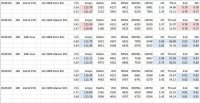I have been fortunate enough to be involved with a group of really great guys that have contributed a great deal to our understanding of motor and prop production. Bryan is certainly one at the top of the list. Last week, I mailed out a box of props that we are testing, and they arrived in MI where TimmyC has been able to test some of them, along with some of his own, on the DM5335-189Kv motor. He sent me the log data for analysis and this is what I have come up with. I hope you find it as valuable as we do in comparing motor, prop, and battery setups.
Here is a clear view of what Tim's data looks like. First, I want to thank Tim for this great data documentation and taking the time to try different props on different batteries. The results are revealing, to say the least. Great data, and if we can continue to get data this well executed, we'll have some true comparisons. This is what I posted on another thread and many may have seen it already.
I took some time to think about how to present this since I didn't want to cherry-pick rows because they don't show a true relative comparison that is valuable to us. Peak values are meaningless since they last for seconds, and are more likely an electrical anomaly. I'm still open to suggestions, but for this round, I ended up with a view that shows two things... how the power starts off, and how the power settles in later, over a short period of timer. How things end up several minutes later are mostly about the battery pack's potential, so skewing prop and Kv values with battery health is something I did not want to include.
The data takes all 100% throttle readings sorted by time. Each power combo is labeled with motor, Kv, prop specs, and the battery specs. The output is represented in two rows per combo. The first row is the average of the top ten rows of data after the first three or four rows are eliminated since they typically have no statistical relativity. The second row represents the average of rows 40 through 50. This will illustrate where the power settles in without going too far into the capabilities of the battery.
The data columns represented are Volts per cell, Amps, Watts, the calculated Watts-out using the calculated pK and recorded RPMs, the calculated HP, the calculated Thrust, the Kv efficiency, which is the difference between the calculated unrestricted RPMs and the recorded RPMs, and the Watts efficiency, which is the margin between the recorded Watts-in and the calculated Watts-out.
Keep in mind that the true power is represented by the power needed to spin a prop of a specific size and load to a specific RPM. We have the prop specs, and we have the load, so the Watts-out and HP represents the output of the motor with that prop.
Values highlighted in red are relatively low values, and high values are highlighted in blue.

